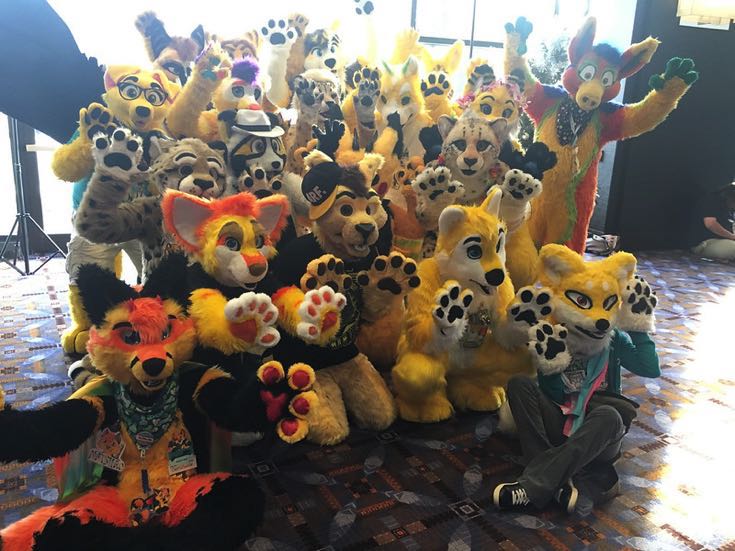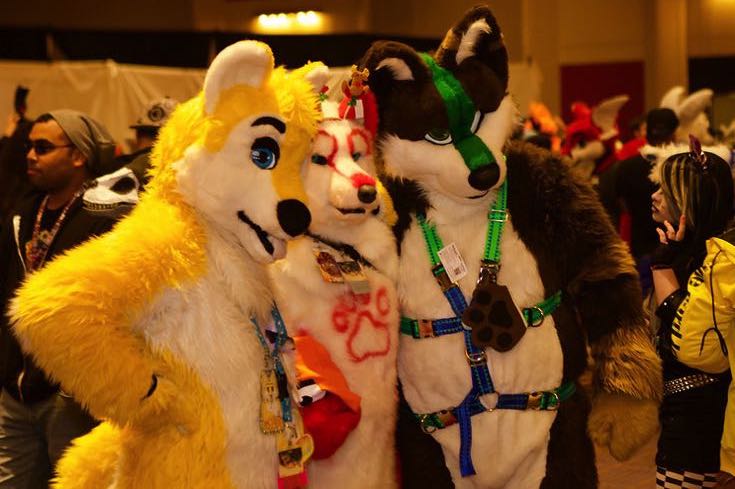The vast majority of people around the world have a hobby. Some people like to play golf, for example, whilst others enjoy knitting. There are some who spend long periods of time in the gym and there are those that find pleasure in painting. Most of the time, what other people get up to in their spare time is entirely understandable and most of us could even envision doing it ourself. Sure, we’re unlikely to become a scratch golfer any time soon or knit a scarf for our partner, but we can wrap our head around why someone might enjoy it and even dabble in it ourselves every now and again should the mood take us.
It is fair to say that the same sort of thing cannot be said about the world of ‘furries’. With around a quarter of a million people in the United States of America identifying as a furry, it isn’t exactly the most widespread of subcultures. At the same time, it isn’t one that can easily be ignored and is unquestionably fascinating to those of us that have not got involved with it. In essence, it is people that enjoy dressing up as animals. Sometimes this can be as part of a sexual fetish, though more often than not it is simply because it is a fun way of escaping from the real world and there is no sexual link to it whatsoever.
What Is a Furry?
The first thing to explain, then, is what a ‘furry’ actually is. In order to offer a succinct summary of them we will turn to the American National Library of Medicine, which says:
Furries are individuals who are especially interested in anthropomorphic or cartoon animals (e.g., Bugs Bunny). They often strongly identify with anthropomorphic animals and create fursonas, identities of themselves as those anthropomorphic animals. Some practice fursuiting, or wearing costumes that resemble anthropomorphic animals.
The obvious thing that a lot of people are likely to think about furries is that it must be a sexual kink. We will look at that in more detail later, but the National Library of Medicine says, “Furries have been portrayed as sexually motivated in the media and popular culture, although little empirical research has addressed this issue.” In other words, it is possible that some furries may engage in the activity out of a sexual motivation, but that isn’t definitely why people engage in such an activity. Instead, it is more about enjoying anthropomorphic animals and wanting to spend time dressing up as one or interacting with others.
According to one person interviewed for a university newspaper, “The one thing you have to do to be a furry is say you are a furry.” Not everyone who identifies as a furry will enjoy dressing up or have a ‘fursona’. Instead, they simply like to look at anthropomorphic animals and have an interest in them that might go past the level of interest that most people would call ‘normal’. In many ways, being a furry is similar to other fandoms, such as anime or cosplay, with those engaging in it choosing their own level of participation and labelling themselves as ‘furries’ depending on how much they want to be part of the overall community.
Is It Weird?

As well as wondering whether or not it’s sexual, another obviously question that many people will ponder is whether or not it is ‘weird’. The answer, of course, is likely to be entirely personal. There will be many that consider homosexuality or transsexuality ‘weird’, but that doesn’t mean that either of them actually are. There are many that think the world of furries is misunderstood, with those involved in the furry fandom being writers, researchers, programmers or artists in their everyday life. There are many who make money in the world of film, costume and entertainment in general, with the links being clear.
Unfortunately, we live in an age when politicians and others, especially those on the right of the political spectrum, are keen to paint anything that they can as ‘wrong’ or ‘weird’. In fact, it is not uncommon for people to direct false information about furries into the public image in order to stigmatise those that might engage in the action of being a ‘furry’. With a large percentage of the furry fandom being neurodivergent and/or members of the LGBTQ+ community, it is hardly surprising that people on the right-wing would fail to appreciate that it is a nuanced activity that is about what people love rather than some sort of ‘kink’.
What Makes Furries Tick
Whilst not all furries will engage with the action of wearing a ‘fursuit’ or creating a ‘fursona’, the fact that it does happen means that there will always be accusations that furries have something ‘wrong’ with them. After all, many people enjoy art but don’t feel the need to dress up as a painting. Of course, it would be very difficult for all furries to have the same motivation to join the movement, so, much like with the suits that they were, there is no one-size-fits-all answer to what it is that makes a furry tick. It is likely that everyone will have their own motivation and their own reason for joining up with other furries.
One person took to Reddit to explain why they became a furry, for example. They began to go through a period of depression when they were younger, they said, needing to find a way out of the dark. That ‘way out’ ended up involving them being ‘a tiger’. They wanted to have the traits associated with the animal, such as aggression, prowess, strength and confidence. As time went on and the thought process helped them to escape their depression, they realised that it was more than just a metaphor and that they actually wanted to be a tiger, which is how it was that they got involved the word of furries.
The Reddit poster made the point that a lot of the demographic is made up of those in the mid-to-late teens, which is a period of life in which people are trying to find themselves. Similarly, those in their teen years are more likely to develop depression and may identify as something that might become a furry in order to make themselves feel stronger or more capable, just as the original poster did. It can be about developing who are as a person in the form of an animal and the characteristics that that animal has, perhaps even changing their furry avatar as they change and develop as a person.
It isn’t Always Sexual
When the National Library of Medicine was investigating the world of furries, 334 male furries that had been recruited from the internet were spoken to about their motivation to join the movement. Interestingly, 84% of those spoken to identified as non-heterosexual, whilst 99% of them said that there was some sexual motivation in being a furry. It was nearly universal that those spoken to either felt a sexual attraction to anthropomorphic animals or else became sexually aroused when fantasising about them. Whilst that was the case with the people spoken to by the National Library of Medicine, however, it isn’t always the case.
For a lot of the people who become furries, it is about gaining confidence when they are in their furry suit, freed from the crippling social anxiety that they normally feel. With their real selves hidden, many furries feel as though they can be more outgoing and talkative when they are in their character. With suits taking hundred of hours to make and costing thousands to buy, it would be crazy do that just for a sexual kink. That is to say nothing of the fact that it can get incredibly hot inside the suit, with the wearer literally being covered in fur. That, perhaps, helps to explain why only around a quarter of furries actually own a fursuit.
There Are Often Furry Get-Togethers

The MidWest FurFest get-together of furries saw about one thousand people turn up to interact with one another. By 2018, that had grown to just shy of 11,000 guests, with more than 12,000 turning up in 2020. In other words, it is a growing industry that sees people want to work together to develop a community of like-minded individuals. It is a fandom that is all about inclusivity and acceptance, with many wanting to promote the idea that it is family-friendly. Many of the furries in attendance spent their time hugging fellow furries, dancing and having a good time; a far throw from the sexualised image that some wish to suggest.
Anthropomorphised creatures isn’t something new, with the one of the world’s oldest known works of art, the Paleolithic Löwenmensch sculpture, depicting a man with the head of a lion. Many Egyptian images combine people and animals. The current fanbase has roots in the 1980s, growing out of the likes of sci-fi conventions. Yet it was the advent of the internet that truly allowed furries to begin to organise themselves and arrange get-togethers that are becoming more popular with every passing year. FurFest isn’t the only such gathering of like-minded furries, with others taking place all over the world and becoming more and more accepted by the mainstream.
Why You Might Have Heard About Furries
Smoke makes his first appearance on #FursuitFriday pic.twitter.com/yMoiQWxzPy
— scott chamberlain (@graymuzzle) January 31, 2020
In September 2018, the idea of being a ‘furry’ was something that most people had never heard of when it was suddenly all over the news. That was because a Councilman in Connecticut in the United States of America was ‘outed’ as being a furry. Scott Chamberlain, who served the area of New Milford, was made to step down from his post in the wake of a town resident posting several screenshots of the Councilman’s profile on a private website for ‘furries’ onto Facebook. Chamberlain, it transpired, had a profile on sofurry.com, which was a website catering to ‘furries’ and requiring them to offer a list of their preferences.
This meant that Chamberlain has said what he ‘loves’, what he ‘likes’, what he ‘tolerates’ and what he ‘hates’, with the aim being of customising the content that was sent his way. His own avatar resembled a fox and was called ‘Gray Muzzle’. Chamberlain himself said that the interest that he showed in the sub-culture was because of a fascination with characters, such as Tony the Tiger and Mickey Mouse. He said, “It”s nothing to do with sex; it’s an interest in cartoon animals.” Part of the reason it was controversial and made headlines, however, was that one of the things on Chamberlain’s profile that he said he ‘tolerates’ was rape.
As one commentator put it, “Anyone is free to pursue any hobby of choice, however that doesn’t mean they can represent me as an elected official and endorse the things that are seemingly endorsed on that page.” In fact, Chamberlain’s involvement in ‘Furry Fandom’ in general wasn’t something that the Councilman had ever hidden, writing literature that involved furries and putting them in some sexual situations. It wasn’t his love of the furry life in and of itself that caused the problem, therefore, but the fact that he seemed to suggest that rape was something that could be tolerated, which is obviously abhorrent.

